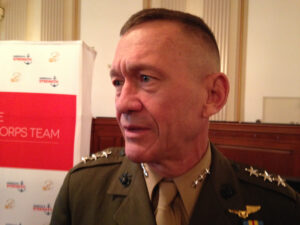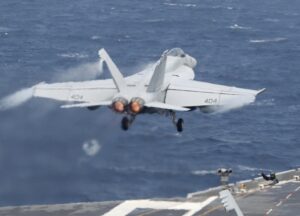
F-35B vertical landing on the amphibious assault ship USS Wasp
WASHINGTON: Of the three variants of Lockheed Martin’s F-35 Joint Strike Fighter, only the carrier-launched F-35C is at risk of being replaced by Boeing’s F-18 Super Hornet, the Marine Corps’s top pilot said today. It’s not on the table to substitute Hornets for either the land-based F-35A variant or the vertical-takeoff-and-landing F-35B, Lt. Gen. Jon Davis, deputy Commandant for aviation said today.
Those instructions come from Defense Secretary Jim Mattis, a former Marine infantryman himself, who on Jan. 27 ordered two “parallel” reviews of the F-35: one of the program in general to find “opportunities to significantly reduce the cost of the F-35”; and one of the F-35C specifically as compared to “an advanced Super Hornet.” Trump had proposed to replace the F-35 — not specifying any particular model — with “a comparable F-18 Super Hornet.”

Lt. Gen. Jon Davis
The comparison has to be “apples to apples,” Davis told the Defense Writers’ Group this morning. “Looking across the mission sets, does a Super Hornet — (specifically an F/A-18E) Block III Super Hornet — match up with and compare with an F-35C? So it’s only F-35Cs, not As, not Bs. It’s only for the Navy carrier air wing.”
“(Since) it’s just F-35C, my stake in that is only four squadrons,” Davis continued. The Marines plan to buy 67 F-35Cs to operate off aircraft carriers alongside Navy squadrons — 10 have been bought to date — and only those Marine aircraft are potentially affected by the review. The vast majority of the Marines’ F-35 buy is B-models, “jump jets” intended to operate off the much shorter decks of amphibious assault ships. Clarifying that the F-35B is not part of the mix marks an important nod of confidence in the Marine aircraft.
Based on the tremendous cost and cost overruns of the Lockheed Martin F-35, I have asked Boeing to price-out a comparable F-18 Super Hornet!
— Donald J. Trump (@realDonaldTrump) December 22, 2016
It’s not such a huge surprise that Mattis ruled out replacing F-35Bs with Super Hornets. All F-18s are designed to operate off carrier decks. There’s no way to make them take off and land vertically, which means there’s no way to fly them from amphibious ships. (They also can’t operate off the short, austere airstrips the Marines envision as forward bases). Unless the Navy decides to assign all of its aircraft carriers to Marine Expeditionary Units — unlikely — neither the Super Hornet nor any other carrier-launched fighter can provide on-call air cover for Marines.

A Navy F/A-18 Super Hornet takes off from the aircraft carrier USS George Washington
F-35 advocates, including many in the military, would argue the so-called fifth generation aircraft can’t be replaced by fourth-generation fighters like the Super Hornet, no matter how you slice the apple. The F-35 is a stealth aircraft, to start with, a capability that can’t be retrofitted onto a Super Hornet, no matter what Boeing has claimed in the past. It also has a unique array of advanced sensors and computers, with the Marines in particular planning to use its hacking and jamming capabilities, supplemented by electronic warfare pods on other aircraft, to replace their aging EA-6B Prowler EW aircraft; the Navy, by contrast, is buying dedicated EW planes, EA-18G Growlers, to complement its F/A-18E Super Hornets.
“I’m highly confident we’re on the right track,” said Davis. While he doesn’t want to prejudge the review, he said, “my sense is we’ll probably end up validating the imperative to have a fifth generation aircraft out there.”
In a ‘world first,’ DARPA project demonstrates AI dogfighting in real jet
“The potential for machine learning in aviation, whether military or civil, is enormous,” said Air Force Col. James Valpiani. “And these fundamental questions of how do we do it, how do we do it safely, how do we train them, are the questions that we are trying to get after.”


























